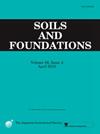基于数值模拟的桩基波传播动力分析
IF 3.3
2区 工程技术
Q2 ENGINEERING, GEOLOGICAL
引用次数: 0
摘要
本文讨论了原位灌注桩(Franki型桩)安装过程中波浪传播数值模拟的初步研究结果。法兰基桩是一种现浇桩,它是通过使用圆柱锤将钢套管打入地面而安装的。这是一种动力桩安装过程,锤头直接将动力传递给安装管内的土体,使高波在土体中传播。成组安装时,单桩打入过程产生的振动可能会对相邻桩的早期混凝土造成破坏。桩在冲击过程中的动力响应非常复杂,涉及锤、桩和土在冲击过程中的相互作用。这种复杂的土-结构相互作用问题可以通过使用实际参数(地面条件、夯击能量等)对桩安装过程进行数值模拟来表示。作为初步研究,利用有限元软件Abaqus对单桩安装进行了模拟。模拟是基于耦合欧拉-拉格朗日(CEL)方法,其中土壤模型采用欠塑性本构模型。目的是调查安装过程中有关离散锤滴影响的部分。在CEL方法中,桩锤被建模为拉格朗日部分,土被处理为欧拉部分。模拟的结果,可以观察到一个真实的振幅模式。该研究可作为后续阶段的基础,后续阶段在原有桩的基础上引入新安装的相邻桩。在这种情况下,评估了相邻桩对相邻桩引起的波传播的影响。本文章由计算机程序翻译,如有差异,请以英文原文为准。
Dynamic analysis of wave propagation due to pile installation using numerical simulations
This paper discusses the results of a preliminary study of numerical simulations investigating wave propagation during the installation of in-situ driven concrete piles (type Franki pile). Franki piles are cast-in-situ piles that are installed by driving a steel casing into the ground using heavy ramming of a cylindrical hammer. It is a dynamic pile installation process where the hammer directly transfers the dynamic forces to the soil within the installation tube causing high wave propagation through the soil. When installed in groups, the vibrations caused by the driving process of one pile may result in damages to the early-age concrete of adjacent piles. The dynamic response of a pile during driving is very complex, involving the interactions of hammer, pile, and soil during the impact. Such complex soil-structure interaction problems can be represented numerically by modeling the pile installation process using realistic parameters (ground conditions, ramming energy etc.). As a preliminary study, a single pile installation is simulated using the FEM software Abaqus. The simulation is based on a Coupled Eulerian-Lagrangian (CEL) approach where the soil is modeled using the hypoplastic constitutive model. The aim is to investigate parts of the installation process regarding the effect of discrete hammer drops. Within the CEL method, the pile hammer is modeled as a Lagrangian part, while the soil is treated as a Eulerian part. As a result of the simulations, a realistic amplitude pattern can be observed. This study serves as the basis for the subsequent phase, wherein a newly installed neighboring pile is introduced alongside the pre-existing pile. In this context, the influence of the adjacent pile on the wave propagation due to the neighboring pile is evaluated.
求助全文
通过发布文献求助,成功后即可免费获取论文全文。
去求助
来源期刊

Soils and Foundations
工程技术-地球科学综合
CiteScore
6.40
自引率
8.10%
发文量
99
审稿时长
5 months
期刊介绍:
Soils and Foundations is one of the leading journals in the field of soil mechanics and geotechnical engineering. It is the official journal of the Japanese Geotechnical Society (JGS)., The journal publishes a variety of original research paper, technical reports, technical notes, as well as the state-of-the-art reports upon invitation by the Editor, in the fields of soil and rock mechanics, geotechnical engineering, and environmental geotechnics. Since the publication of Volume 1, No.1 issue in June 1960, Soils and Foundations will celebrate the 60th anniversary in the year of 2020.
Soils and Foundations welcomes theoretical as well as practical work associated with the aforementioned field(s). Case studies that describe the original and interdisciplinary work applicable to geotechnical engineering are particularly encouraged. Discussions to each of the published articles are also welcomed in order to provide an avenue in which opinions of peers may be fed back or exchanged. In providing latest expertise on a specific topic, one issue out of six per year on average was allocated to include selected papers from the International Symposia which were held in Japan as well as overseas.
 求助内容:
求助内容: 应助结果提醒方式:
应助结果提醒方式:


